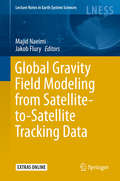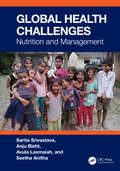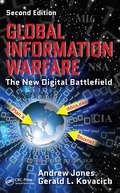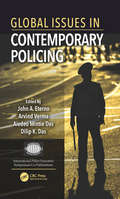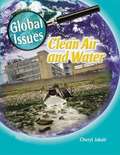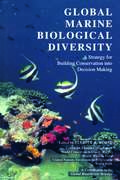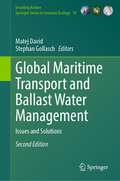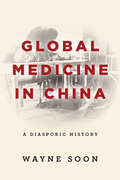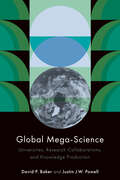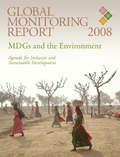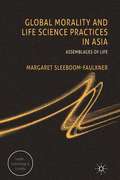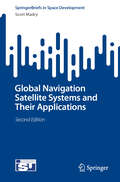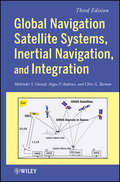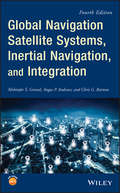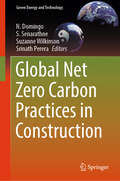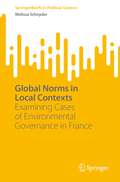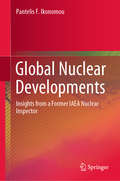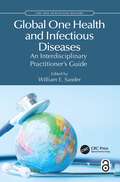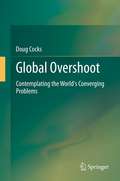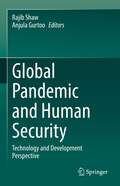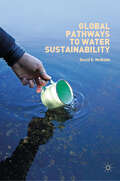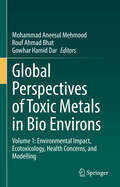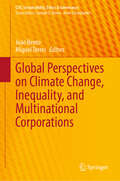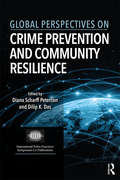- Table View
- List View
Global Gravity Field Modeling from Satellite-to-Satellite Tracking Data
by Majid Naeimi Jakob FluryThis book provides a sound theoretical basis for the the different gravity field recovery methods and the numerics of satellite-to-satellite tracking data. It represents lectures given at the 'Wilhelm and Else Heraeus Autumn School' in Bad Honnef, Germany, October 4-9, 2015. The emphasis of the school was on providing a sound theoretical basis for the different gravity field recovery methods and the numerics of data analysis. The approaches covered here are the variational equations (classical approach), the acceleration approach and the energy balance approach, all of which are used for global gravity field recovery on the basis of satellite observations. The theory of parameter estimation in satellite gravimetry and concepts for orbit determination are also included. The book guides readers through a broad range of topics in satellite gravimetry, supplemented by the necessary theoretical background and numerical examples. While it provides a comprehensive overview for those readers who are already familiar with satellite gravity data processing, it also offers an essential reference guide for graduate and undergraduate students interested in this field.
Global Health Challenges: Nutrition and Management
by Sarita Srivastava Anju Bisht Avula Laxmaiah Anitha SeethaThis book is an up-to-date reference on some of the major global health issues and the role of nutrition in their prevention and management. The book covers undernutrition, degenerative diseases, mental health disorders and COVID-19 and reviews feeding and eating disorders like anorexia, bulimia, binge-eating, and delineates the risk factors and management. The book addresses the gaps in tackling these health problems and proposes comprehensive models and frameworks to manage them.Key Features: Explores practical solutions and management of looming health issues in terms of diet and nutrition Reviews health threats like obesity, diabetes, hypertension and COVID-19 Includes a section on feeding and eating disorders and sustainable models to manage them Covers mental-health issues like depression and dementia Discusses conditions like undernutrition, hidden hunger, and cardiovascular diseases The book is meant for health professionals, nutritionists, and policymakers. It is also useful for post-graduates in public health and nutrition.
Global Information Warfare: The New Digital Battlefield, Second Edition
by Andrew Jones Gerald L. KovacichSince the turn of the century much has happened in politics, governments, spying, technology, global business, mobile communications, and global competition on national and corporate levels. These sweeping changes have nearly annihilated privacy anywhere in the world and have also affected how global information warfare is waged and what must be do
Global Issues in Contemporary Policing (International Police Executive Symposium Co-Publications)
by Arvind Verma Dilip K. Das John A. Eterno Aiedeo Mintie DasThis book addresses six areas of policing: performance management, professional and academic partnerships, preventing and fighting crime and terrorism, immigrant and multicultural populations, policing the police, and cyber-security. The book contains the most current and ground-breaking research across the world of policing with contributors from over 20 countries. It is also a suitable reference or textbook in a special topics course. It consists of edited versions of the best papers presented at the IPES annual meeting in Budapest.
Global Issues: Clean Air and Water
by Cheryl JakabHi there! This is Earth speaking. My environment is being threatened by some serious problems, and I need your help. My global challenge to you is to find ways to manage these issues and to build a sustainable future. The Global Issues series presents six major environmental topics. Each book takes one topic and examines it through five related issues. Each issue outlines the problem and offers solutions for a sustainable future. In Clean Air and Water, learn about the following issues: ISSUE 1 Polluting the air ISSUE 2 Polluting the water ISSUE 3 Fresh drinking water ISSUE 4 Acid rain ISSUE 5 Overuse of water Special features include: * two case studies for each issue * "What can you do?" advice for individuals
Global Marine Biological Diversity: A Strategy For Building Conservation Into Decision Making
by Elliott A. NorseGlobal Marine Biological Diversity presents the most up-to-date information and view on the challenge of conserving the living sea and how that challenge can be met.
Global Maritime Transport and Ballast Water Management: Issues and Solutions (Invading Nature - Springer Series in Invasion Ecology #16)
by Matej David Stephan GollaschIn 2015 the first edition of this book was published before the Ballast Water Management (BWM) Convention entered into force. To our knowledge this was and still is the first comprehensive book on BWM worldwide. It provided an overview of possible solutions to the complex issue of BWM. It further outlined consequences and implications to address the ballast water "problem" in line with provisions of the BWM Convention considering environmental, shipping, legal and policy perspectives. The previously addressed subjects remain essential, but new subjects appeared which more recently have proven to be critical for the effective BWM Convention implementation. After the first book content was already agreed and in preparation, new advances were achieved in BWM-related research around the world. Further, new experience was gained and issues came out during the preparation processes of countries for the BWM Convention implementation. The editors of the first book remained heavily involved in BWM-related research and other processes, hence these new critical BWM issues and subjects are now dealt with in the second edition of this book to complement the first one. In essence, this new book covers main issues that arose recently during the implementation of the BWM Convention. Scientists and experts with extensive experience in these subjects from around the globe from academic and private sectors, as well as national administrations, were involved in the preparation of this book.
Global Medicine in China: A Diasporic History
by Wayne SoonIn 1938, one year into the Second Sino-Japanese War, the Chinese military found itself in dire medical straits. Soldiers were suffering from deadly illnesses, and were unable to receive blood transfusions for their wounds. The urgent need for medical assistance prompted an unprecedented flowering of scientific knowledge in China and Taiwan throughout the twentieth century. Wayne Soon draws on archives from three continents to argue that Overseas Chinese were key to this development, utilizing their global connections and diasporic links to procure much-needed money, supplies, and medical expertise. The remarkable expansion of care and education that they spurred saved more than four million lives and trained more than fifteen thousand medical personnel. Moreover, the introduction of military medicine shifted biomedicine out of elite, urban civilian institutions and laboratories and transformed it into an adaptive field-based practice for all. Universal care, practical medical education, and mobile medicine are all lasting legacies of this effort.
Global Mega-Science: Universities, Research Collaborations, and Knowledge Production
by David P. Baker Justin J.W. PowellNever has the world been as rich in scientific knowledge as it is today. But what are its main sources? In accessible and engaging fashion, Global Mega-Science examines the origins of this unprecedented growth of knowledge production over the past hundred and twenty years. David P. Baker and Justin J.W. Powell integrate sociological and historical approaches with unique scientometric data to argue that at the heart of this phenomenon is the unparalleled cultural success of universities and their connection to science: the university-science model. Considering why science is so deeply linked to (higher) educational development, the authors analyze the accumulation of capacity to produce research—and demonstrate how the university facilitates the emerging knowledge society. The age of global mega-science was built on the symbiotic relationship between higher education and science, especially the worldwide research collaborations among networked university-based scientists. These relationships are key for scholars and citizens to understand the past, future, and sustainability of science.
Global Monitoring Report 2008
by World Bank'Global Monitoring Report 2008', the fifth in an annual series, is essential reading for those who wish to follow the global development agenda and debate in 2008. The year marks the midpoint toward the 2015 deadline for achieving the Millennium Development Goals (MDGs). It is also an important year to work toward a consensus on how the world is going to respond to the challenge of climate change, building on the foundation laid at the Bali climate change conference in December 2007. The report spans this agenda. It provides a comprehensive assessment of progress toward the MDGs and related policies and actions. It addresses the challenge of climate change and environmental sustainability and assesses its implications for development. The report's assessment of MDGs at midpoint presents a mixed picture, one of both significant progress and formidable challenges. The first MDG, reducing extreme poverty by half, is likely to be met at the global level, thanks to a remarkable surge in global economic growth over the past decade. But, on current trends, the human development MDGs are unlikely to be met. Prospects are gravest for the goals of reducing child and maternal mortality, but shortfalls are also likely in the primary school completion. nutrition, and sanitation MDGs. The potential effects of climate change compound the challenge of achieving the development goals and sustaining progress. The report's messages are clear: urgent action is needed to help the world get back on track to achieve the MDGs; and urgent action is also needed to combat climate change that threatens the well-being of all countries, but particularly of poor countries and poor people. The goals of development and environmental sustainability are closely related, and the paths to those goals have important synergies.
Global Morality and Life Science Practices in Asia
by Margaret Sleeboom-FaulknerEmpirical studies of life science research and biotechnologies in Asia show how assemblages of life articulate bioethics governance with global moralities and reveal why the global harmonization of bioethical standards is contrived.
Global Navigation Satellite Systems and Their Applications (SpringerBriefs in Space Development)
by Scott MadryProfessor Madry, one of the world's leading experts in the field of the practical applications of satellites and space technologies, provides in a condensed form, a quick yet comprehensive overview of all aspects of satellite navigation. This new edition concisely addresses the latest breakthrough technologies, the various national systems, the many applications, the regulatory issues, and the strategic implications of satellite navigation systems. The future directions of autonomous aircraft and the role drones play in satellite navigation networks are also evaluated. Moreover, the industry's strengths and weaknesses are discussed, as well as reviews of all the various national systems now being deployed. The motivation behind the proliferation of these systems, in this book, evaluates the overall societal and ethical issues of these invisible yet pervasive parts of our modern digital world.
Global Navigation Satellite Systems, Inertial Navigation, and Integration
by Mohinder S. Grewal Angus P. Andrews Chris G. BartoneAn updated guide to GNSS, and INS, and solutions to real-world GNSS/INS problems with Kalman filtering Written by recognized authorities in the field, this third edition of a landmark work provides engineers, computer scientists, and others with a working familiarity of the theory and contemporary applications of Global Navigation Satellite Systems (GNSS), Inertial Navigational Systems, and Kalman filters. Throughout, the focus is on solving real-world problems, with an emphasis on the effective use of state-of-the-art integration techniques for those systems, especially the application of Kalman filtering. To that end, the authors explore the various subtleties, common failures, and inherent limitations of the theory as it applies to real-world situations, and provide numerous detailed application examples and practice problems, including GNSS-aided INS (tightly and loosely coupled), modeling of gyros and accelerometers, and SBAS and GBAS. Drawing upon their many years of experience with GNSS, INS, and the Kalman filter, the authors present numerous design and implementation techniques not found in other professional references. The Third Edition includes: Updates on the upgrades in existing GNSS and other systems currently under development Expanded coverage of basic principles of antenna design and practical antenna design solutions Expanded coverage of basic principles of receiver design and an update of the foundations for code and carrier acquisition and tracking within a GNSS receiver Expanded coverage of inertial navigation, its history, its technology, and the mathematical models and methods used in its implementation Derivations of dynamic models for the propagation of inertial navigation errors, including the effects of drifting sensor compensation parameters Greatly expanded coverage of GNSS/INS integration, including derivation of a unified GNSS/INS integration model, its MATLAB® implementations, and performance evaluation under simulated dynamic conditions The companion website includes updated background material; additional MATLAB scripts for simulating GNSS-only and integrated GNSS/INS navigation; satellite position determination; calculation of ionosphere delays; and dilution of precision.
Global Navigation Satellite Systems, Inertial Navigation, and Integration
by Mohinder S. Grewal Angus P. Andrews Chris G. BartoneCovers significant changes in GPS/INS technology, and includes new material on GPS, GNSSs including GPS, Glonass, Galileo, BeiDou, QZSS, and IRNSS/NAViC, and MATLAB programs on square root information filtering (SRIF) This book provides readers with solutions to real-world problems associated with global navigation satellite systems, inertial navigation, and integration. It presents readers with numerous detailed examples and practice problems, including GNSS-aided INS, modeling of gyros and accelerometers, and SBAS and GBAS. This revised fourth edition adds new material on GPS III and RAIM. It also provides updated information on low cost sensors such as MEMS, as well as GLONASS, Galileo, BeiDou, QZSS, and IRNSS/NAViC, and QZSS. Revisions also include added material on the more numerically stable square-root information filter (SRIF) with MATLAB programs and examples from GNSS system state filters such as ensemble time filter with square-root covariance filter (SRCF) of Bierman and Thornton and SigmaRho filter. Global Navigation Satellite Systems, Inertial Navigation, and Integration, 4th Edition provides: Updates on the significant upgrades in existing GNSS systems, and on other systems currently under advanced development Expanded coverage of basic principles of antenna design, and practical antenna design solutions More information on basic principles of receiver design, and an update of the foundations for code and carrier acquisition and tracking within a GNSS receiver Examples demonstrating independence of Kalman filtering from probability density functions of error sources beyond their means and covariances New coverage of inertial navigation to cover recent technology developments and the mathematical models and methods used in its implementation Wider coverage of GNSS/INS integration, including derivation of a unified GNSS/INS integration model, its MATLAB implementations, and performance evaluation under simulated dynamic conditions Global Navigation Satellite Systems, Inertial Navigation, and Integration, Fourth Edition is intended for people who need a working knowledge of Global Navigation Satellite Systems (GNSS), Inertial Navigation Systems (INS), and the Kalman filtering models and methods used in their integration.
Global Net Zero Carbon Practices in Construction (Green Energy and Technology)
by Srinath Perera Suzanne Wilkinson N. Domingo S. SenarathneThis book covers a spectrum of pivotal topics, including the precise definition and metrics of net zero carbon, the integration of low carbon practices, stakeholder engagement, collaboration on carbon emissions in construction, and building life cycle requirements to achieve net zero carbon. Its importance lies in providing actionable insights and practical knowledge to stakeholders, empowering them to implement effective measures for reducing carbon footprints in construction projects. The target audience for this book encompasses professionals in the construction industry, sustainability experts, policymakers, educators, and students engaged in the fields of architecture, engineering, and environmental studies, who aspire to spearhead positive change in the global construction landscape.
Global Norms in Local Contexts: Examining Cases of Environmental Governance in France (SpringerBriefs in Political Science)
by Melissa SchnyderThis Brief discusses the translation of global environmental norms across local contexts in France. It provides a snapshot of how global-level environmental norms travel vertically across levels of governance, from the global to the local, and asks how global environmental norms are (re)interpreted by local-level actors and translated to a particular local context. Chapters focus on three in-depth case studies, each involving multi-stakeholder environmental governance: (1) the Cerbère-Banyuls Marine Nature Reserve, (2) the Thau Fisheries Local Action Group (FLAG), and (3) the Biovallée biodistrict. In each of these cases, the author assesses how twilight norms are used to frame, promote, and generally develop a local discourse that centers on environmental conservation and sustainability. By combining concepts from the literature on norm localization with processes from the literature on norm-based institutional change, this Brief will generate new insights on the dynamic aspects of norm translation. As such, it will be of interest to researchers studying environmental politics, comparative policy, governance, and norms.
Global Nuclear Developments: Insights from a Former IAEA Nuclear Inspector
by Pantelis F. IkonomouWritten by a former International Atomic Energy Agency (IAEA) nuclear inspector and nuclear security expert, this book provides a comprehensive and authentic overview of current global nuclear developments. The author provides detailed insights into current and past nuclear crises and reveals the technical capabilities, political strategies and motives of nuclear weapon owners. By analyzing the nuclear programs and strategies of various countries, including the USA, Russia, China, Great Britain and France, this book highlights the existing global nuclear threat and the risks it entails for humanity. It also describes the current blockades and suggests possible ways out. Given its scope, the book will appeal to scholars and policymakers interested in gaining new insights into sensitive or complex nuclear programs in various countries.
Global One Health and Infectious Diseases: An Interdisciplinary Practitioner’s Guide (CRC One Health One Welfare)
by William E. SanderWhile many terms relate to One Health, the idea remains the same: to think outside a chosen area of specialty and work collaboratively as part of a team to improve health status around the world. This involves the collective effort of physicians, veterinarians, public health practitioners, ecologists, anthropologists, social workers, economists, and many others. Collectively, these are the Global One Health practitioners.Through the lens of infectious disease, this book brings together the diverse range of topics necessary to be an effective global health practitioner at the intersection of human and animal health, particularly in developing countries. It explores what an aspiring or mid-career practitioner should be aware of when working with infectious diseases, including technical skills, cultural competency, capacity building, big data, and understanding the landscape and history of global health. Each chapter focuses on a specific area of necessary knowledge with background information, case examples, and resources to use moving forward.An important reference for upper-level undergraduate students, graduate students, and early practitioners in human, animal, and public health, this text highlights the competencies rather than focusing on the problems in Global One Health. It provides a blueprint of areas that the reader should pay attention to, particularly in the realm of infectious diseases.Chapter 13 ‘One Health Education, Training, and Capacity Building’ is available to read Open Access at https://www.taylorfrancis.com/books/9781032140674.
Global Overshoot
by Doug CocksGlobal Overshoot is a multidisciplinary analysis (including history and pre-history) from an ecological and evolutionary perspective of the contemporary world system. This book compares and critiques attitudes held by people with different world views to the hypothetical prospect of large widespread falls in quality of life. It also draws insights from these two analyses to develop and suggest a philosophy of Ecohumanism to people of good will who want to think constructively about the world's converging problems, i.e. think altruistically and 'think like an evolving ecosystem.'
Global Pandemic and Human Security: Technology and Development Perspective
by Rajib Shaw Anjula GurtooThis book highlights how the human security aspect has been affected by the global pandemic, based on the specific case study, field data, and evidence. COVID-19 has exemplified that the pandemic is global, but its responses are local. The responses depend on national governance and policy framework, use of technology and innovation, and people’s perceptions and behavior, among many others. There are many differences in how the pandemic has affected the rich and the poor, urban and rural sectors, development and fiscal sectors, and developed and developing nations and communities.Echoing human security principles, the 2030 Agenda emphasized a “world free of poverty, hunger, disease and want… free of fear and violence… with equitable and universal access to quality education, health care, and social protection….to safe drinking water and sanitation… where food is sufficient, safe, affordable and nutritious… where habitats are safe, resilient and sustainable…and where there is universal access to affordable, reliable and sustainable energy.” These basic human security [PA1] principles and development agenda are highly affected by the global pandemic worldwide, irrespective of its development and economic status. Thus, the book highlights the nexus between human security and development issues. It has two major pillars, one is the development and the other is technology issues. These two inter-dependent topics are discussed in the perspective of the global pandemic, making this the most important feature of this book.While the world is still in the middle of a pandemic, and possibly other natural and biological hazards may affect peoples’ lives and livelihoods in the future, this book provides some key learning, which can be used to cope with future uncertainties, including climate risks. Thus, the book is timely and relevant to wider readers.
Global Pathways to Water Sustainability
by David E. McNabbThis book investigates the current and future state of freshwater and the global drive to achieve the UN sustainability goal. It first explores the major barriers to achieving the goal and then examines some of the programs water managers are adopting to overcome those barriers. These programs include finding new ways to supplement existing water supplies, and greater acceptance of alternative supplies, such as recycled waste water and desalination; green infrastructures, and rain and storm water harvesting. It concludes with two chapters on water management tools, including asset management and strategic planning, which are of particular interest to small water and wastewater utilities.
Global Perspectives for Local Action: Using TIMSS to Improve U.S. Mathematics and Science Education
by National Research CouncilThe Third International Mathematics and Science Study (TIMSS) raised the alarm about U.S. mathematics and science education. Most Americans are now aware that U.S. students lag behind their peers in other developed nations. In one state, the legislature reacted by lengthening the school year, assuming that more time on academic content would boost student performance. Some educators have fixed the blame on the mathematics and science curricula typically used in U.S. schools.Does the problem lie in the curricula, instruction, or the system of support available to teachers? This book presents the first comprehensive analysis of TIMSS study--a half-million students from 15,000 schools around the world. It presents detailed reports on three major aspects of education, including curriculum issues, teaching practices, and school support.
Global Perspectives of Toxic Metals in Bio Environs: Volume 1: Environmental Impact, Ecotoxicology, Health Concerns, and Modelling
by Rouf Ahmad Bhat Mohammad Aneesul Mehmood Gowhar Hamid DarThis book explores recent advances in heavy metal contamination research in a global context, and focusses on the role of recent technologies like recombinant bioremediation, phytoremediation, DNA technology and nanotechnology to provide sustainable managing strategies to mitigate adverse environmental and health impacts. Many heavy metals are used in industrial and commercial sectors, including iron, zinc, tin, lead, copper, tungsten, cadmium, arsenic, chromium, thallium, and lead, which, when disposed in the natural environment, lead to serious threats to ecological balance in biotic systems and threaten vulnerable human populations. Currently, global scientific communities are very worried about the detrimental health effects of these heavy metals and their adverse effects on almost all biological systems. Scientific research has recorded some alarming adverse impacts of heavy metals on biota like carcinogenesis, mutagenesis, teratogenesis, allergic interactions, endocrine-disruption, bone marrow damage, osteoporosis. and immune system damage. This book is therefore timely, and will be of interest to researchers, students professors, and policymakers examining toxic heavy metals in the environment and their adverse health impacts.
Global Perspectives on Climate Change, Inequality, and Multinational Corporations (CSR, Sustainability, Ethics & Governance)
by João Bento Miguel M. TorresComprising a collection of selected research papers, this book discusses the challenges related to climate change mitigation and adaptation. It adds valuable insights into the link between climate change, global inequality, and multinational corporations. Bringing together an international range of prominent authors, this book interests academics, students, and practitioners. It serves as a valuable guide for policymakers in environmental sustainability. This book encourages researchers to think more broadly about the implications of multinational corporations concerning global inequality and climate change. It deepens understanding of how foreign direct investments can contribute to a more sustainable future and overcome environmental challenges.
Global Perspectives on Crime Prevention and Community Resilience (International Police Executive Symposium Co-Publications)
by Dilip K. Das Diana Scharff PetersonInspired by the dialogue between practitioners and academics of nearly thirty countries, this edited volume includes updated articles on global crime prevention initiatives and best practices in building community resilience presented at the International Police Executive Symposium’s (IPES) 25th annual meeting in Sofia, Bulgaria in 2014. A new book in the highly-regarded IPES Co-Publications series, Global Perspectives on Crime Prevention and Community Resilience offers strategies for crime and violence prevention and community initiatives for crime reduction, while promoting current best practices for police effectiveness, safety, and professionalism. The book includes eighteen chapters from police leaders, practitioners and academics around the world in efforts to demonstrate effective strategies for the prevention of crime and innovative techniques in assisting crime victims. In an increasingly global reality, this text gives voice to valuable members of the international policing community.
